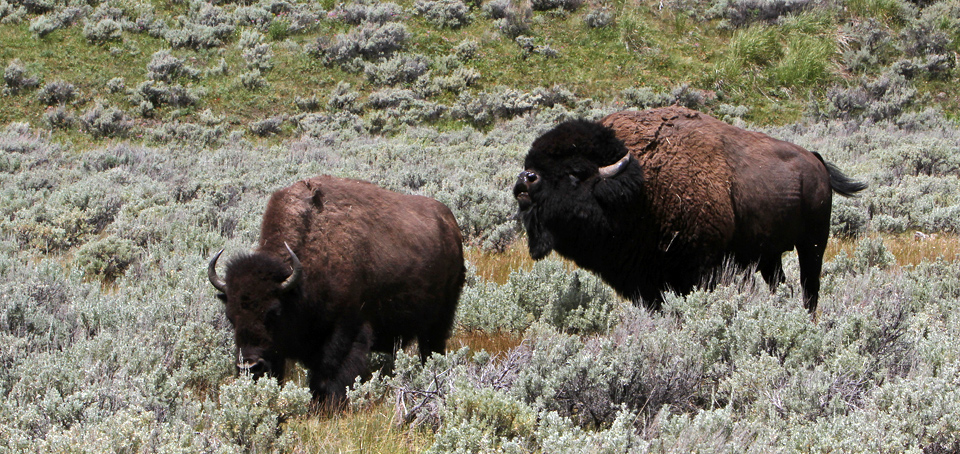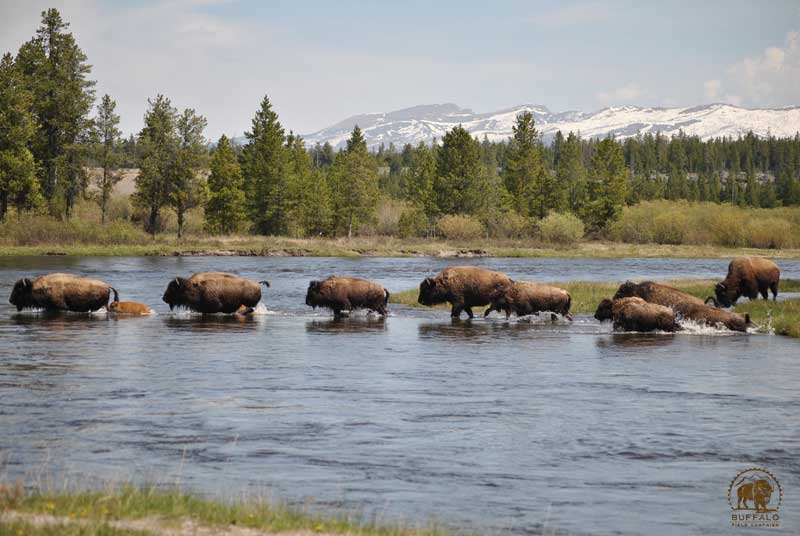Bison and buffalo are two terms often used interchangeably in everyday conversation, but they are not entirely synonymous. Both are large, hooved, herbivorous mammals, yet they belong to different species and inhabit distinct geographical regions. While the terms ‘bison’ and ‘buffalo’ may seem interchangeable, they have unique characteristics that set them apart. This article aims to delve into the differences between these two magnificent creatures, exploring their physical attributes, habitats, and the historical context surrounding their names.
What’s the Difference Between Bison and Buffalo?
Many people often use the terms bison and buffalo interchangeably, but they are not exactly the same. This article will delve into the differences between these two large mammals, providing detailed information on their origins, physical characteristics, and habitats.
Origin and Classification
The term buffalo is often used to refer to the African Cape buffalo or the Asian water buffalo. However, in North America, the term is frequently applied to the American bison. This confusion stems from early European settlers who called the bison buffalo due to their physical resemblance to the African and Asian buffalo. In reality, the American bison belongs to the genus Bison, while the African Cape buffalo belongs to the genus Syncerus, and the Asian water buffalo belongs to the genus Bubalus.
Physical Characteristics
American bison, or buffalo, are large, hooved, herbivorous mammals with a shaggy brown coat. They can weigh up to 2,200 pounds and reach heights of up to 6 feet at the shoulder. In contrast, the African Cape buffalo, or Cape buffalo, are also large, but they have a more muscular build and larger horns. They can weigh up to 2,000 pounds and reach heights of up to 5 feet. The Asian water buffalo, or water buffalo, are slightly smaller, weighing up to 1,200 pounds and reaching heights of up to 6 feet.
Habitat
American bison primarily inhabit grasslands and prairies in North America, particularly in the United States and Canada. They are well adapted to the harsh, cold climates of these regions. The African Cape buffalo, on the other hand, are found in eastern and southern Africa, where they inhabit grasslands, savannas, and forests. The Asian water buffalo is native to the Indian subcontinent and Southeast Asia, and they are often found in wetland areas, such as swamps and grasslands.
Diet
American bison are primarily herbivores, feeding on a variety of grasses, including tall grasses and short grasses. They also eat twigs, bark, and leaves during the winter months when grasses are scarce. The African Cape buffalo and the Asian water buffalo are also herbivores, but their diets vary slightly. The African Cape buffalo feeds on grasses, leaves, and fruits, while the Asian water buffalo consumes aquatic plants, grasses, and crops.
Conservation Status
The American bison, or buffalo, is considered a near threatened species by the International Union for Conservation of Nature (IUCN). Historically, they were hunted to near extinction, but conservation efforts have helped to increase their populations. The African Cape buffalo is listed as least concern on the IUCN Red List, although they face threats from poaching and habitat loss. The Asian water buffalo is listed as endangered due to habitat loss and hybridization with domestic water buffalo.
| Species | Weight | Height | Habitat | Diet | Conservation Status |
|---|---|---|---|---|---|
| American Bison (Buffalo) | Up to 2,200 pounds | Up to 6 feet | Grasslands and prairies in North America | Grasses, twigs, bark, and leaves | Near Threatened |
| African Cape Buffalo | Up to 2,000 pounds | Up to 5 feet | Eastern and southern Africa | Grasses, leaves, and fruits | Least Concern |
| Asian Water Buffalo | Up to 1,200 pounds | Up to 6 feet | Indian subcontinent and Southeast Asia | Aquatic plants, grasses, and crops | Endangered |
Are buffalo and bison the same thing?
What are buffalo?
Buffalo are large, hooved, herbivorous mammals native to Africa and Asia. The term buffalo can refer to two main species: the African buffalo (Syncerus caffer) and the Asian buffalo (Bubalus bubalis). Both species are known for their large size, powerful build, and long horns. They are often found in grasslands, forests, and wetlands, and are herbivores, feeding on grasses, leaves, and aquatic plants.
What are bison?
Bison are large, hooved, herbivorous mammals native to North America and Europe. There are two main species of bison: the American bison (Bison bison) and the European bison (Bison bonasus). They are known for their shaggy coats, curved horns, and robust build. They inhabit grasslands, forests, and mountainous regions, and feed on grasses, shrubs, and other vegetation.
No, buffalo and bison are not the same thing. While both are large, hooved, herbivorous mammals, they belong to different species and are native to different continents. The term buffalo typically refers to the African and Asian species, while bison refers to the North American and European species. The confusion between the two terms arises from the common use of buffalo to refer to the American bison, especially in the context of the historical American buffalo. However, this usage is considered incorrect and can lead to confusion.
- Both buffalo and bison are large, hooved, herbivorous mammals.
- They belong to different species and are native to different continents.
- The term buffalo typically refers to the African and Asian species, while bison refers to the North American and European species.
Why are buffalo called bison now?
Historical Context
Historically, the term buffalo was used to refer to the American bison. This confusion arose from the early European settlers who mistook the American bison for the African Cape buffalo. The term buffalo was commonly used in the 19th century to describe the American bison, leading to widespread confusion and misconception. However, in recent years, efforts have been made to clarify the distinction between the two species.
Scientific Classification
The American bison, also known as the American buffalo, is classified as Bison bison. This species is native to North America and is a distinct species from the African Cape buffalo, which is classified as Syncerus caffer. The term bison is now widely used in scientific and conservation circles to refer to the American bison, while buffalo is often used in more casual contexts or in reference to the African Cape buffalo.
Conservation Efforts
Conservation efforts have played a significant role in the shift towards using the term bison instead of buffalo. Many organizations, such as the National Bison Association, advocate for the use of the term bison to accurately reflect the scientific classification of the species. This change in terminology aims to raise awareness about the importance of preserving the American bison and its unique place in North American ecosystems.
- Efforts to preserve the American bison include habitat conservation and reintroduction programs.
- The National Bison Association promotes the use of the term bison to accurately reflect the scientific classification of the species.
- Conservation efforts aim to raise awareness about the importance of preserving the American bison and its unique place in North American ecosystems.
Does Yellowstone have bison or buffalo?
What’s the Difference Between Bison and Buffalo?
While the terms bison and buffalo are often used interchangeably, there is a distinct difference between the two. Bison are native to North America, while buffalo are native to Asia and Africa. The American bison, which is what resides in Yellowstone National Park, is often referred to as an American buffalo. However, technically speaking, it is not a buffalo. It’s worth noting that both terms are used to refer to the same animal in common language.
Yellowstone’s Bison Population
Yellowstone National Park is home to the largest free-roaming bison herd in the United States. The park’s bison population fluctuates, but it typically ranges between 4,000 to 5,000 animals. These bison are a significant part of the park’s ecosystem, playing a crucial role in maintaining the park’s natural balance. They can be found throughout the park, particularly in the Lamar Valley, which is often referred to as the Serengeti of North America due to its abundant wildlife.
Conservation Efforts for Yellowstone’s Bison
Conservation efforts are in place to protect Yellowstone’s bison population. The park’s bison are considered a conservation herd because they are free of cattle genes and diseases. This makes them vital for maintaining the genetic integrity of the species. The National Park Service works closely with other federal and state agencies, as well as tribal governments, to manage the bison population and ensure their continued health and well-being. This includes implementing measures to prevent the spread of diseases and managing the population size to maintain a healthy balance within the park’s ecosystem.
- Conservation efforts include managing the bison population size to prevent overgrazing and maintain a healthy balance within the park’s ecosystem.
- Preventing the spread of diseases, such as brucellosis, which can be transmitted to domestic livestock, is crucial for maintaining the health of the bison herd.
- Collaboration with other federal and state agencies, as well as tribal governments, is essential for the long-term conservation of the bison herd.
Are there any buffalo in the United States?
Historical Significance of Buffalo in the United States
Buffalo, also known as American bison, have played a significant role in the history and culture of the United States. These large, hooved mammals were once abundant across the country, with estimates suggesting that there were between 30 and 60 million buffalo roaming freely before the arrival of European settlers. The buffalo was an essential part of Native American life, providing food, clothing, and tools. However, with the expansion of European settlements and the development of railroads, the buffalo population drastically declined due to overhunting and habitat loss.
Current Status of Buffalo in the United States
Today, there are approximately 30,000 wild bison in the United States, with the majority living in national parks, wildlife refuges, and Native American reservations. The largest free-roaming herd can be found in Yellowstone National Park, Wyoming, with around 4,000 animals. Conservation efforts are in place to protect and increase the buffalo population, including the reintroduction of bison to their natural habitats and the establishment of bison conservation herds.
Conservation and Management of Buffalo Populations
Conservation and management of buffalo populations in the United States involve several strategies, including:
- Protected Areas: National parks, wildlife refuges, and Native American reservations provide a safe habitat for buffalo to roam freely without the threat of human interference or poaching.
- Reintroduction Programs: Conservation efforts involve reintroducing bison to their natural habitats, increasing genetic diversity and population sizes.
- Collaboration with Tribes and Stakeholders: Working with Native American tribes and other stakeholders to develop and implement effective conservation strategies that benefit both the buffalo and local communities.
- Research and Monitoring: Scientists study buffalo behavior, habitat, and population dynamics to better understand how to manage and conserve these animals effectively.
These efforts aim to ensure the long-term survival of the American bison and restore their role in the country’s ecosystems and cultural heritage.
Frequently Asked Questions
What is the difference between bison and buffalo in terms of their physical characteristics?
Bison and buffalo are often used interchangeably, but they are two distinct species with some physical differences. Bison, also known as American buffalo, are large, hooved mammals native to North America. They have a large body with a brownish-red coat, a shaggy mane around their neck, and a prominent hump on their back. Their horns are short and curved upwards. On the other hand, buffalo, specifically the African or Asian buffalo, are slightly smaller and have a more slender build. They have a dark brown or black coat, a less prominent hump, and longer, more curved horns. The main difference lies in their body size and horn shape.
What are the differences in their habitats and behaviors?
Bison and buffalo inhabit different parts of the world and exhibit distinct behaviors. Bison are native to North America, primarily inhabiting grasslands and prairies. They are herbivores, feeding on grasses, leaves, and twigs. They are known for their annual migrations in search of food and are generally more docile. Buffalo, on the other hand, are found in Africa and Asia, living in forests, grasslands, and wetlands. They are also herbivores but tend to be more aggressive, especially when feeling threatened or provoked. They live in large herds and are known for their strength and endurance.
How do bison and buffalo differ in terms of their conservation status?
The conservation status of bison and buffalo varies. Bison, despite being a national symbol of the United States, were once on the brink of extinction due to overhunting. However, conservation efforts have helped increase their numbers, and they are now classified as Near Threatened on the IUCN Red List. Buffalo, specifically the African buffalo, are listed as Least Concern due to their widespread distribution and large population. However, the Asian buffalo is classified as Endangered due to habitat loss and hunting.
What are the cultural and historical significance of bison and buffalo?
Both bison and buffalo hold significant cultural and historical importance. Bison were a crucial part of Native American culture, providing food, clothing, and tools. They were also a symbol of abundance and provision. In the United States, they are considered a national symbol and are featured on the official seal of the Department of the Interior. Buffalo, particularly the African buffalo, are revered in many African cultures for their strength and resilience. They are also an important part of many Asian cultures, featuring in various myths and legends. Historically, they were hunted for their meat and hides, leading to a decline in their populations.
I’ve been working in technology and IT since 1993 and on the Internet as a blogger and webmaster since 2004. I love technology, gadgets, movies and travel. I love researching and writing about technology, travel and cars.




